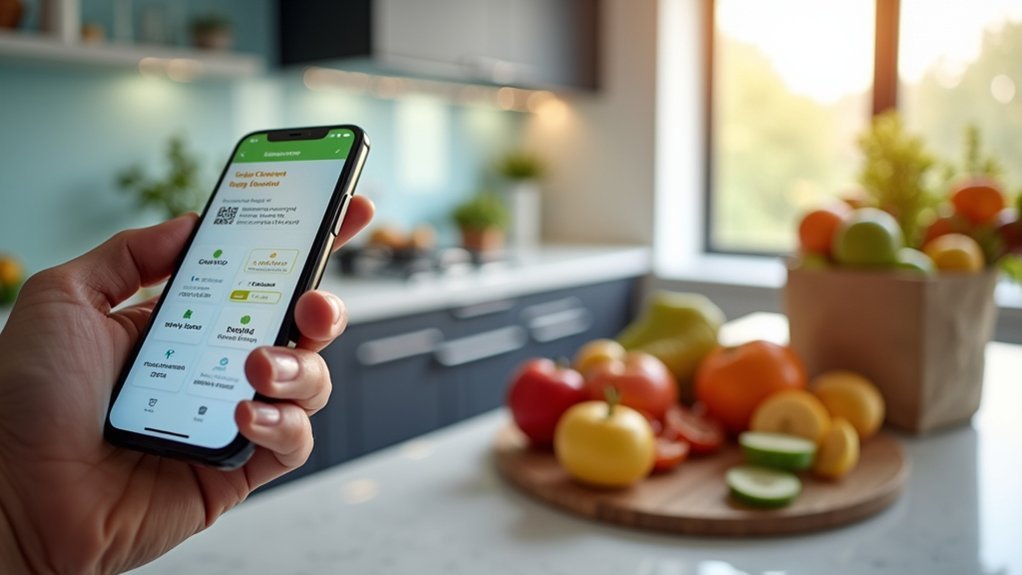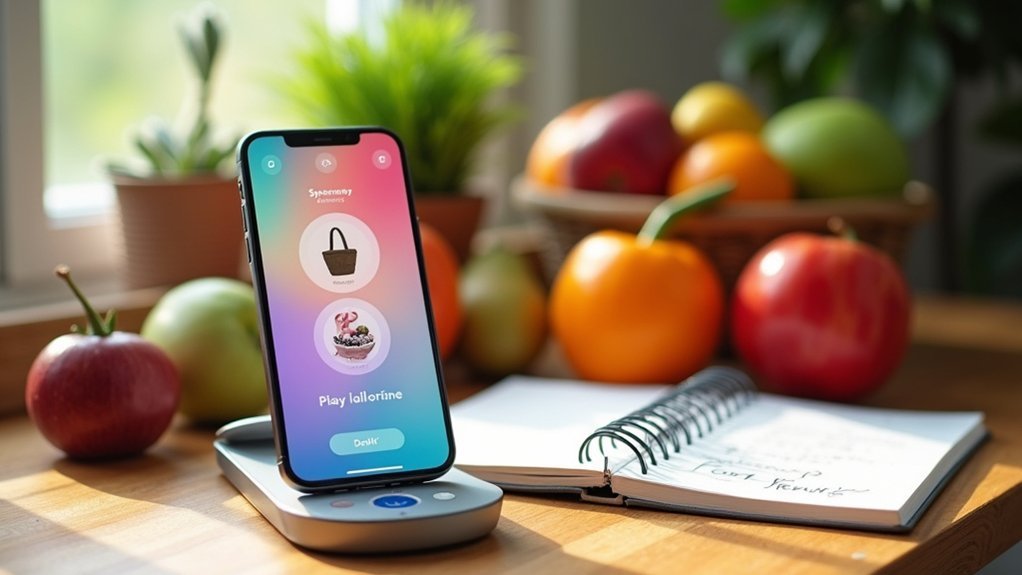Start by downloading MyFitnessPal and entering your personal details to establish customized calorie goals. You’ll log food using the app’s 20+ million item database or barcode scanner for packaged items, while manually entering homemade meals and recipes. Track exercise through the activity database or sync with fitness trackers for automatic updates. Monitor your progress using visual charts that display calorie balance, weight changes, and nutrient patterns. Master these features to access thorough calorie management strategies.
Setting Up Your Calorie Tracking Account
Before you can start tracking your calories effectively, you’ll need to download MyFitnessPal from the Apple or Android store and create a free account using your email address and password.
During setup, you’ll enter personal details like age, weight, height, and activity level to establish personalized daily calorie goals. You can customize your goals by selecting weight loss, maintenance, or muscle gain targets that align with your fitness aspirations.
Setting up personalized calorie goals based on your unique stats and fitness objectives ensures more accurate and achievable results.
Once your account’s ready, you can log your food intake using the extensive food database containing over 20 million items or the convenient barcode scanner.
Integrating fitness devices with MyFitnessPal enhances your calorie tracking experience by syncing workouts and daily steps, giving you thorough insight into your calorie expenditure.
Navigating Essential App Features and Tools
Once you’ve completed your initial setup, you’ll discover that modern fitness apps offer powerful features designed to streamline your calorie tracking experience.
Your calorie counter app’s extensive database that contains millions of food entries makes finding specific items effortless. Use the barcode scanner to instantly log packaged foods, or leverage voice logging when you’re eating on-the-go.
The macro tracking feature breaks down your daily calorie intake into proteins, carbs, and fats, helping you maintain balanced nutrition aligned with your health goals.
Many apps sync seamlessly with your fitness tracker, combining food tracking data with exercise metrics. These integrated tools provide thorough insights into your eating patterns, enabling you to make informed dietary decisions that support your weight management objectives.
Logging Food Items Using Barcode Scanners

Among these innovative features, barcode scanners stand out as game-changers for efficient food logging.
You’ll find that fitness apps like MyFitnessPal let you quickly scan packaged items, automatically pulling nutritional data from their extensive food database containing over 20 million items. This streamlined approach eliminates manual entry time while ensuring you track calories with remarkable precision.
When you scan barcodes, you’re accessing standardized nutrition information directly from manufacturers, delivering accurate food data every time.
This enhanced user experience encourages more frequent meal logging, helping you maintain consistent caloric intake tracking.
You’ll appreciate how barcode scanners transform tedious food logging into an effortless process, making it easier to stick with your dietary goals and develop better tracking habits.
Creating Custom Meals and Recipes
While barcode scanning works perfectly for packaged foods, you’ll need a different approach for homemade dishes and custom recipes. Most fitness apps let you create custom meals by manually entering each ingredient and its quantity. You’ll input everything from olive oil to vegetables, building a complete nutritional profile for your dish.
Once created, you can save these custom meals for future logging, making it incredibly efficient when you prepare the same recipes repeatedly. This feature streamlines your meal planning process considerably. The apps calculate your total caloric intake and provide detailed macronutrient breakdowns, helping you understand your nutritional intake better.
Many fitness apps also allow you to share your custom meals with the community, inspiring others while discovering new food ideas for your own routine.
Recording Exercise and Physical Activity
Most fitness apps transform exercise tracking into a seamless process by offering extensive databases of physical activities and automatic syncing capabilities. You can manually log workouts or sync fitness trackers to automatically track steps, exercises, and calories burned throughout your day.
These fitness apps provide thorough databases covering everything from common gym exercises to unique activities, ensuring accurate calorie calculations for any physical activity you perform.
You’ll benefit from setting personalized goals and monitoring your progress through detailed charts and graphs that visualize your fitness improvements over time.
This consistent recording helps you maintain a complete picture of your calorie balance while building accountability and establishing sustainable exercise habits that support your long-term health objectives.
Understanding Macronutrient Breakdowns
Beyond simply counting calories, fitness apps provide detailed macronutrient breakdowns that help you understand what fuels your body most effectively.
These macronutrients—carbohydrates, proteins, and fats—each serve distinct purposes in energy production and overall health. When you track your food intake, you’ll discover the caloric value differences: carbohydrates and proteins contain 4 calories per gram, while fats provide 9 calories per gram.
Fitness apps like MyFitnessPal let you set specific macronutrient targets as percentages of your daily intake, whether you’re pursuing weight loss, muscle gain, or maintenance.
Setting Realistic Daily Calorie Goals
You’ll need to calculate your Basal Metabolic Rate (BMR) first, which represents the calories your body burns at rest to maintain basic functions.
Once you’ve determined your BMR using a calculator, you must adjust this number based on your activity level to find your Total Daily Energy Expenditure (TDEE).
This TDEE calculation gives you the foundation for setting realistic daily calorie goals that align with your weight loss or maintenance objectives.
Calculate Your BMR
Understanding your Basal Metabolic Rate (BMR) forms the foundation for setting realistic daily calorie goals that actually work.
You’ll need to use the Mifflin-St Jeor equation: for men, BMR = 10 × weight (kg) + 6.25 × height (cm) – 5 × age (years) + 5, and for women, subtract 161 instead of adding 5.
Once you’ve calculated your BMR, multiply it by your activity level factor to determine your TDEE.
Most fitness apps automatically perform these calculations using your personal data.
For effective weight management, create a calorie deficit of 500-1,000 calories daily from your TDEE.
This approach guarantees you’re losing 1-2 pounds weekly safely while maintaining your body’s essential functions.
Adjust for Activity
While your BMR provides the baseline calories your body needs to function, you must account for daily activities to establish accurate calorie targets. You’ll need to calculate your Total Daily Energy Expenditure (TDEE) by multiplying your BMR with an activity level multiplier.
| Activity Level | Multiplier | Daily Life Examples |
|---|---|---|
| Sedentary | 1.2 | Office work, minimal exercise |
| Lightly Active | 1.375 | Light exercise 1-3 days/week |
| Moderately Active | 1.55 | Moderate exercise 3-5 days/week |
| Very Active | 1.725 | Heavy exercise 6-7 days/week |
| Extremely Active | 1.9 | Physical job + intense training |
Fitness apps like MyFitnessPal provide personalized calorie recommendations by syncing with activity trackers. Adjust your calorie intake based on whether you’re targeting weight loss or muscle gain, then set realistic calorie goals within your chosen app.
Syncing With Wearable Devices and Other Apps
Since most fitness enthusiasts use multiple devices and apps to monitor their health, MyFitnessPal’s ability to sync with over 35 fitness devices and apps becomes a game-changer for thorough tracking.
This syncing capability allows you to integrate data from popular fitness trackers like Fitbit, Apple Watch, and Garmin directly into MyFitnessPal’s platform.
When you connect your wearable devices, you’ll automatically track steps, workouts, and weight without manual input.
This seamless integration consolidates your health tracking data in one place, giving you a complete overview of your calorie intake versus physical activity.
You’ll receive more accurate calorie adjustments based on actual exercise, helping you make informed dietary choices and understand how your fitness habits impact caloric expenditure throughout the day.
Monitoring Progress Through Visual Charts
When you open fitness apps like MyFitnessPal, you’ll immediately notice how visual charts transform complex calorie data into easily digestible graphics that reveal your progress at a glance.
These calorie tracker interfaces feature customizable dashboards that display your tracking progress through colorful graphs and trends. You can monitor multiple metrics simultaneously: weekly calorie averages, weight changes, and nutrient intake comparisons.
The visual charts help you identify patterns in your eating habits, making it easier to adjust your approach for better results. Whether you’re pursuing weight loss goals or maintaining current health levels, these graphical representations provide clear feedback on your efforts.
This visual accountability system motivates continued engagement with fitness apps, as you’ll see tangible evidence of your dietary choices and their impact on your overall wellness journey.
Troubleshooting Common Tracking Challenges
You’ll inevitably encounter tracking challenges that can derail your calorie counting accuracy.
The most frequent issues include finding incorrect nutritional information in food databases, missing barcode scan results for packaged items, and syncing problems between your fitness tracker and app.
These obstacles can frustrate your progress monitoring, but they’re manageable with the right troubleshooting strategies.
Inaccurate Food Database Entries
Although fitness apps offer vast food databases with millions of entries, you’ll often encounter inaccurate nutritional information that can derail your calorie tracking efforts. Many apps like MyFitnessPal rely on user-generated entries, which create inconsistencies in serving sizes and nutritional data.
Community-driven databases, while extensive, contain errors from preparation variations and user misestimations.
To maintain accurate tracking, you should verify entries against reliable sources or food packaging labels. When you spot discrepancies, manually input or correct the information yourself.
Utilize barcode scanning features whenever possible, as these provide standardized nutritional information directly from manufacturers’ labels, greatly reducing errors.
Regular app updates improve database accuracy, but you’ll still need to stay vigilant to guarantee your tracking remains precise and reliable.
Missing Barcode Scan Results
Barcode scanning failures can disrupt your calorie tracking workflow, but several troubleshooting steps will get you back on track. When your app’s barcode scanner produces missing barcode scan results, start by cleaning the product’s barcode and ensuring it’s unobstructed. Smudges or damage prevent accurate scanning.
| Solution | Action | Result |
|---|---|---|
| Clean Barcode | Remove smudges/damage | Improved scan accuracy |
| Update App | Download latest version | Enhanced scanner performance |
| Manual Entry | Input nutritional information | Complete calorie tracking |
| Contact Support | Report persistent issues | Future database improvements |
If the item isn’t in the app’s food database of over 20 million foods, you can manually enter the nutritional information for tracking calories. Keep your app updated for ideal scanner performance, and contact support when issues persist.
Syncing Device Data Issues
When fitness trackers and apps won’t sync properly, your calorie tracking data becomes fragmented across multiple platforms. This disrupts your overall health monitoring and makes accurate calorie counting nearly impossible.
To resolve syncing device data issues with your fitness app:
- Check compatibility first – Confirm your device works with your chosen fitness app, as MyFitnessPal supports over 35 different apps and devices.
- Install the latest app updates – Newer versions often fix syncing problems and improve device compatibility.
- Verify your account settings – Manually enable sync features in both your fitness app and device settings.
- Review privacy settings – Strict privacy controls can block data sharing between platforms.
For persistent troubleshooting issues, consult your app’s support center or community forums for specialized solutions.
Frequently Asked Questions
Can You Track Calories on the Fitness App?
Yes, you can track calories on fitness apps. You’ll log your food intake using their extensive databases, scan barcodes for quick entry, and monitor your daily caloric intake against personalized recommendations based on your goals.
Can a Fitness Tracker Track Calories?
Yes, you can use a fitness tracker to monitor calories burned during activities. It’ll calculate your expenditure using heart rate, movement data, weight, and age to give you real-time feedback on energy burned.
What Is the Best Fitness App to Count Calories?
MyFitnessPal’s the best fitness app for counting calories. You’ll access over 20 million food items, track macronutrients easily, and use barcode scanning. It’s free with premium options, earning 3.5 million five-star ratings.
What Calorie Counting App Syncs With Apple Fitness?
MyFitnessPal syncs perfectly with Apple Fitness, letting you integrate workout data and track calories burned. You’ll get personalized calorie goals that automatically adjust based on your Apple Fitness activities and exercise routines.





Leave a Reply